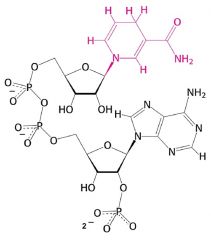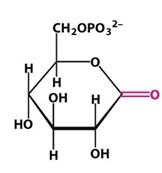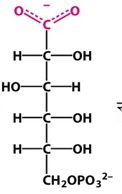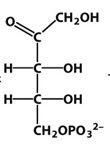![]()
![]()
![]()
Use LEFT and RIGHT arrow keys to navigate between flashcards;
Use UP and DOWN arrow keys to flip the card;
H to show hint;
A reads text to speech;
36 Cards in this Set
- Front
- Back
|
What 3 things can form glucose 6-phosphate in one step? |
1. Glucose 2. Glucose 1-phosphate 3. Fructose 2,6-phosphate |
|
|
The pentose phosphate pathway is an important source of what? |
NADPH |
|
|
What 4 synthesis pathways need NADPH? |
1. Fatty acid biosynthesis 2. Cholesterol biosynthesis 3. Neutrotransmitter biosynthesis 4. Nucleotide biosynthesis |
|
|
What 2 detoxification pathways require NADPH? |
1. Reduction of Oxidized glutathione 2. Cytochrome P450 monooxygenases |
|

|
NADPH
Notice the extra phosphate on 2' OH of adenine! |
|
|
NADPH is the source of what? |
Biosynthetic reducing power in ALL organisms |
|
|
The metabolism of what by the pentose phosphate pathway generates NADPH? |
Glucose 6-phosphate |
|
|
What are the 2 phases of the pentose phosphate pathway? |
1. The oxidative generation of NADPH 2. The nonoxidative interconversion of sugars |
|
|
In the oxidative phase, 2 NADPH is generated when what occurs? |
When glucose 6-phosphate is oxidized to ribulose 5-phosphate via glucose 6-phosphate dehydrogenase |
|
|
Glucose 6-phosphate to Ribulose 5-phosphate produces what? |
2 NADPH molecules and CO2! |
|
|
What are the 4 steps to make Ribulose 5-phosphate? |
1. Glucose 6-phosphate (START) 2. 6-phosphoglucono-lamda-lactone 3. 6-phospho-gluconate 4. Ribulose 5-phosphate |
|
|
How is Glucose 6-phosphate converted into 6-phosphoglucono-lamda-lactone? |
Glucose 6-phosphate dehydrogenase catalyzes the oxidation reaction of NADP+ |
|
|
How is 6-phosphoglucono-lamda-lactone converted into 6-phospho-gluconate? |
Lactonase catalyzes the hydrolysis |
|
|
How is 6-phospho-gluconate converted into Ribulose 5-phosphate? |
6-phosphogluconate dehydrogenase catalyzes the oxidation reaction with NADP+ |
|

What is it and where did it come from? |
6-Phosphoglucono-lamda-lactone is made from Glucose 6-phosphate via glucose 6-phosphate dehydrogenase. |
|

What is it and where did it come from? |
6-Phospho-gluconate is made from 6-Phosphoglucono-lamda-lactone via Lactonase. |
|

What is it and where did it come from? |
Ribulose 5-phosphate is made from 6-Phosphogluconate via 6-Phosphogluconate dehydrogenase. |
|
|
What converts Ribulose 5-phosphate into Ribose 5-Phosphate? |
Phosphopentose isomerase |
|
|
What 2 enzymes create a reversible link between the pentose phosphate pathway and glycolysis? How? |
Transketolase and transaldolase create a link by catalyzing 3 successive reactions |
|
|
3 pentose sugars can be made into what? |
2 hexose and 1 triose |
|
|
Transketolase and transaldolase create a link by catalyzing 3 successive reactions. What is the 1st one? |
Formation of Glyceraldehyde 3-phosphate and Sedoheptulose 7-phosphate from two pentoses via transketolase |
|
|
What forms Glyceraldehyde 3-phosphate and Sedoheptulose 7-phosphate via transketolase? |
Xylulose 5-phosphate and Ribose 5-phosphate |
|
|
Transketolase and transaldolase create a link by catalyzing 3 successive reactions. What is the 2nd one? |
Formation of Fructose 6-phosphate and Erythrose 4-phosphate via transaldolase |
|
|
How is Ribulose 5-phosphate converted to Xylulose 5-phosphate? |
Phosphopentose epimerase |
|
|
What forms Fructose 6-phosphate and Erythrose 4-phosphate via transaldolase? |
Glyceraldehyde 3-phosphate and Sedoheptulose 7-phosphate |
|
|
Transketolase and transaldolase create a link by catalyzing 3 successive reactions. What is the 3rd one? |
Formation of Fructose 6-phosphate and Glyceraldehyde 3-phosphate via Transketolase |
|
|
What forms Fructose 6-phosphate and Glyceraldehyde 3-phosphate via Transketolase? |
Erythrose 4-phosphate and Xylulose 5-phosphate |
|
|
Excess ribose 5-phosphate formed by the pentose phosphate pathway can be what? |
Completely converted into glycolytic intermediates |
|
|
In the number of C, list the nonoxidative phase reactions of the pentose phosphate pathway. Don't forget the enzymes! |
1. C5 + C5 <--> C3 + C7 (Transketolase) 2. C3 + C7 <--> C6 + C4 (Transaldolase) 3. C4 + C5 <--> C6 + C3 (Transketolase) |
|
|
What cofactor transfers 1-carbon units? |
Biotin! |
|
|
What are the 4 modes cells use the pentose phosphate pathway? |
1. Cells need ribose for nucleotides 2. Cells need NADPH for biosynthesis AND ribose for nucleotides 3. Cells need ONLY NADPH for biosynthesis 4. Cells need BOTH NADPH and ATP |
|
|
Why would cells need ribose 5-phosphate more than NADPH? |
If they are rapidly dividing, they need ribose to synthesize nucleotide precursors for DNA |
|
|
In Mode 1 of the Pentose Phosphate Pathway, what is the nonoxidative phase doing? |
Converting 2 molecules of Fructose 6-phosphate and 1 molecule of glyceraldehyde 3-phosphate
into 3 molecules of ribose 5-phosphate. |
|
|
In Mode 2 of the Pentose Phosphate Pathway, what is the predominant reaction? |
The formation of 2 NADPH and 1 molecule of ribose 5-phosphate (by isomerization) from 1 glucose 6-phosphate.
The pathway essentially STOPS at the end of the oxidative phase. |
|
|
In Mode 3 of the Pentose Phosphate Pathway, what 3 things are occurring? |
1. Oxidative phase of the Pentose Phosphate Pathway 2. Non-oxidative phase 3. Gluconeogenesis of glucose 6-phosphate from fructose 6-phosphate and glyceraldehyde 3-phosphate. |
|
|
In Mode 4 of the Pentose Phosphate Pathway, what happens? |
Fructose 6-phosphate and glyceraldehyde 3-phosphate derived from the non-oxidative phase enter the glycolytic pathway to form ATP. |

